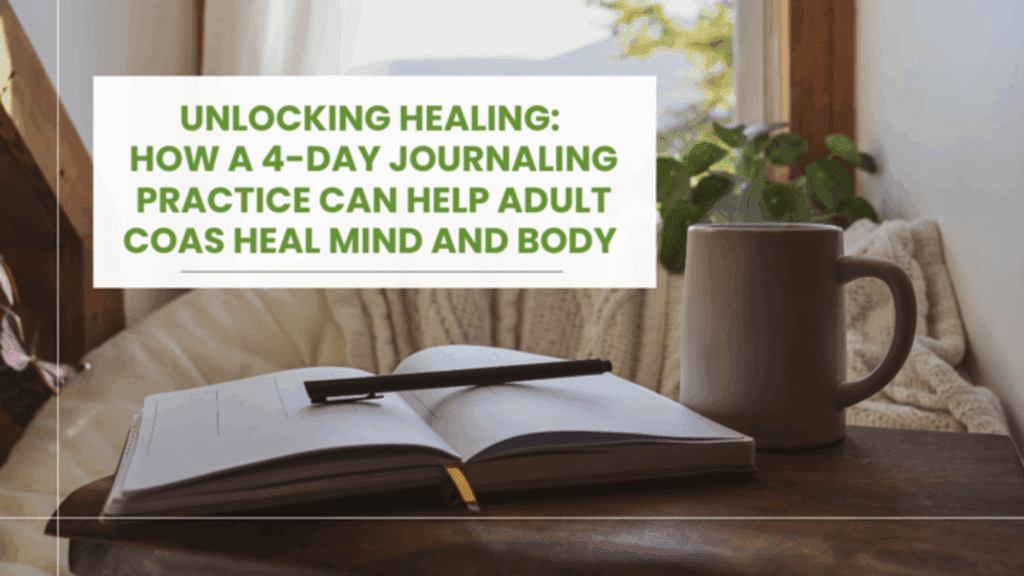Growing up in a home affected by a parent’s substance use disorder can create lasting ripples throughout our lives. Many adult children of addiction/alcoholics (ACOAs) carry silent wounds—adverse childhood experiences (ACEs), chronic stress, and deep emotional scars that can affect mental and physical health for years.
Healing from these experiences can feel overwhelming. But powerful, research-backed tools are emerging to help. One such tool is a basic, structured 4-day journaling practice, strongly supported by science and discussed by Dr. Andrew Huberman, a professor of neurobiology at Stanford University.
This blog explores how this short, powerful writing method can help ACOA’s start or deepen their healing journey, building resilience and improving overall well-being.
The Science Behind the 4-Day Journaling Method
The 4-day journaling process Dr. Huberman discusses is based on extensive research into how expressive writing impacts brain and body health. The foundation of this method traces back to Dr. James Pennebaker’s groundbreaking studies in the 1980s. Pennebaker and subsequent researchers found that structured expressive writing can:
• Reduce symptoms of anxiety, depression, and PTSD 80340D
• Improve immune function and decrease physical symptoms
• Lower blood pressure and stress hormone levels
• Promote emotional processing and cognitive reorganization of traumatic experiences
When we write about emotional experiences in a focused, intentional way, the act seems to “free up” mental resources that were being used to suppress painful memories. This restructuring allows for new perspectives, emotional release, and, over time, improved mental and physical health.
Dr. Huberman highlights that even a short commitment—about 15–20 minutes per day over four consecutive days—can lead to long-lasting positive changes in health and mood.
Why This is Especially Powerful for ACOAs?
If you grew up in a chaotic, unpredictable environment with a parent with a substance use disorder, you may have learned early on to suppress emotions to survive. While that coping strategy may have been necessary during childhood, it can leave unprocessed pain lodged in the mind and body.
The 4-day writing process offers a safe, private, and self-directed way to begin exploring and releasing that suppressed pain—without judgment and at your own pace.
Research shows that adult survivors of ACEs who engage in expressive writing experience notable improvements not only in mental health outcomes, but also in immune system function, suggesting profound mind-body healing.
Getting Started with the 4-Day Journaling Method
Here’s a simple guide to get started:
1. Pick Your Time and Space
o Choose a quiet place where you won’t be interrupted.
o Plan to write for about 15–20 minutes each day for four consecutive days.
2. Choose Your Focus
o Write about an emotional experience that has deeply affected you—this could be events from your childhood, relationships, or struggles you still carry.
o You are encouraged to be honest and open; this writing is for your eyes only unless you choose to share it.
3. Follow These Simple Rules
o Write continuously for the full time. Don’t worry about grammar, spelling, or sentence structure.
o Focus on your deepest thoughts and feelings.
o If you feel stuck, keep writing whatever comes to mind related to the experience.
4. Allow Your Story to Evolve
o Across the four days, it’s natural for your writing to shift. You may find yourself gaining new perspectives or connecting different events.
5. Be Gentle with Yourself
o Emotional writing can stir up strong feelings. That’s normal. Allow yourself time to rest and care for yourself after each session.
Important Notes for Safety and Support
• If at any point this writing process feels overwhelming, pause and reach out for support.
• NACoA encourages all individuals to seek professional help when needed. This journaling method can be a powerful supplement but is not a substitute for therapy or professional support.
• Healing is a journey. You are allowed to go at your own pace.
A Tool Among Many
At NACoA, we believe that healing is possible. There is no one-size-fits-all approach. The 4-day expressive writing method is one tool—a powerful, evidence-based one—that you can add to your healing toolkit.
Whether you are just beginning to explore your past or are deepening your growth, know that you are not alone. Every step you take toward healing is courageous. And every word you write can be a doorway to reclaiming your story, your voice, and your future.
References
1. Pennebaker, J. W., & Beall, S. K. (1986). Confronting a traumatic event: Toward an understanding of inhibition and disease. Journal of Abnormal Psychology, 95(3), 274–281.
2. Smyth, J. M. (1998). Written emotional expression: Effect sizes, outcome types, and moderating variables. Journal of Consulting and Clinical Psychology, 66(1), 174–184.
3. Huberman, A. (2023). The Science of Journaling: How Writing Can Improve Mental and Physical Health. Stanford University, Huberman Lab Podcast.
4. Baikie, K. A., & Wilhelm, K. (2005). Emotional and physical health benefits of expressive writing. Advances in Psychiatric Treatment, 11(5), 338–346.
